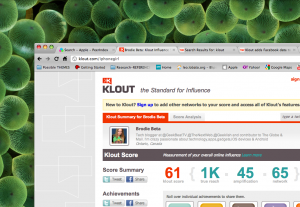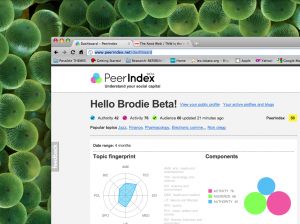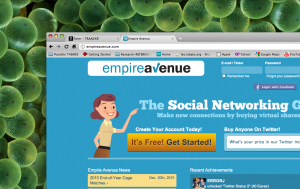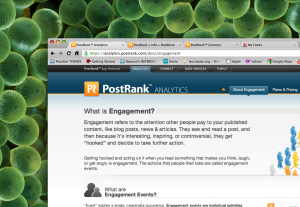
 Asking someone if they’ve ever seen an episode of Jersey Shore may elicit the same response as if you asked “Have you ever Googled yourself?” Look, we know you have on both counts whether you’ll admit it or not. So in the spirit of narcissistic superficiality we present you with 7 ways to measure your influence online.
Asking someone if they’ve ever seen an episode of Jersey Shore may elicit the same response as if you asked “Have you ever Googled yourself?” Look, we know you have on both counts whether you’ll admit it or not. So in the spirit of narcissistic superficiality we present you with 7 ways to measure your influence online.
All kidding aside, if you’re managing a company or a personal brand online, the following services will help you understand how your message is getting across.
Klout
 Klout has become one of the more popular choices for measuring influence online. It measures a users impact on the web and provides a series of results; klout score, true reach, amplification and network. The total Klout score is calculated by your true reach (the size of your engaged audience) + amplification (the likelihood that content will be clicked) + network (the score of your engaged audience).
Klout has become one of the more popular choices for measuring influence online. It measures a users impact on the web and provides a series of results; klout score, true reach, amplification and network. The total Klout score is calculated by your true reach (the size of your engaged audience) + amplification (the likelihood that content will be clicked) + network (the score of your engaged audience).
Klout uses both Twitter and Facebook data to tally the influence results and it rewards users with badges that can be shared. These social achievements are earned by gaining more “Klout” by increasing your reach and obtaining more unique retweets.
Do you participate? Are you a good listener? A section called the Influence Matrix measures your online personality and will display how engaged you are with your audience. There’s also a feature that finds the individuals that you’re most influenced by and who’s influenced by you. All in all, there’s quite a bit of information that you might find useful such as how many unique retweets you have, and your inbound/outbound message ratios.
PeerIndex
 PeerIndex helps you “understand your social capital” by collecting data from Twitter, Facebook and LinkedIn. Authority, activity and audience is the mixture that calculates a users overall PeerIndex rank within its community. It also uses a four month date range to show you where you sit within the Topic Fingerprint, a feature that displays eight benchmarked topics including; arts & media, technology & Internet and politics & news. Obviously, my Topic Fingerprint was heavily leaning to technology.
PeerIndex helps you “understand your social capital” by collecting data from Twitter, Facebook and LinkedIn. Authority, activity and audience is the mixture that calculates a users overall PeerIndex rank within its community. It also uses a four month date range to show you where you sit within the Topic Fingerprint, a feature that displays eight benchmarked topics including; arts & media, technology & Internet and politics & news. Obviously, my Topic Fingerprint was heavily leaning to technology.
PeerIndex offers an analytics dashboard that gives users a closer look at their authority on the web, and it also compares you to your friends. By default it picks a few random people to compare you with, however, any Twitter user you choose can be added to the comparison graph. Linking a site or blog to your profile will additionally help the service improve the accuracy of the authority results.
EmpireAvenue
 EmpireAvenue turns your online engagement into a game. It’s a social stock market game that rewards users with virtual currency for all of their activity online. Tweets, commenting on YouTube and sharing stuff on Facebook will all earn you Eaves (EmpireAvenue dollars). Each user (player) starts off with a unique stock symbol and a share price that increases the more you share and the more people interact with your content. And, other users who were smart enough to invest in you, will also receive dividends the more you engage.
EmpireAvenue turns your online engagement into a game. It’s a social stock market game that rewards users with virtual currency for all of their activity online. Tweets, commenting on YouTube and sharing stuff on Facebook will all earn you Eaves (EmpireAvenue dollars). Each user (player) starts off with a unique stock symbol and a share price that increases the more you share and the more people interact with your content. And, other users who were smart enough to invest in you, will also receive dividends the more you engage.
Users can earn Eaves from their activity on Twitter, Facebook, Flickr, YouTube and Facebook fan pages as well as unlock badges. EmpireAvenue doesn’t offer a powerful analytics dashboard like the other services we mentioned in this article however, it’s an interesting service nonetheless. And it does have numerous features that post influencers on a rank list, both inside and outside the EmpireAvenue community. At the end of the day, we’ll have to just assume that it properly calculates engagement through its use of shares. By the way, my BBETA stock has gone up +11.449 since I started writing this review — I’m rich!
Postrank
 Postrank uses a wide variety of social networks to calculate your overall social influence. But, it also connects brands/companies with bloggers and publishers that are influential within their communities or niche. So by using Postrank, you’re advertising your social popularity so brands can connect with you. Digg, Twitter, Facebook, Delicious, Flickr, GitHub, Google Profile, LinkedIn and Indentica can all be added to your Postrank profile along with your website.
Postrank uses a wide variety of social networks to calculate your overall social influence. But, it also connects brands/companies with bloggers and publishers that are influential within their communities or niche. So by using Postrank, you’re advertising your social popularity so brands can connect with you. Digg, Twitter, Facebook, Delicious, Flickr, GitHub, Google Profile, LinkedIn and Indentica can all be added to your Postrank profile along with your website.
This service will give users in-depth information about their online presence however the sign-up process is a bit frustrating to say the least. Users are required to add a website to complete the sign-up process, but after following the multiple server-side steps to get it verified, I was personally left with nothing. The errors I’m receiving could be an anomaly, and I’m hoping they are because there appears to be a wealth of information within Postrank personal analytics.
Without my site being verified, I can only tell you what I’ve learned from the site about the analytics. Postrank offers a scoring system that calculates the level of engagement from your audience. And, the engagement is scored by what Postrank calls the five C’s of engagement; creating, critiquing, chatting, collecting and clicking. On the surface, it looks powerful.
Backtype
 Backtype will show you the social impact of a URL. A blog, Twitter, Facebook and YouTube URLs can all be input, Backtype doesn’t seem to discriminate. Inputting a Twitter URL will glean information about the account such as who’s influencing the them, their overall Backtype score and a list of the sites that they share the most. Backtype calculates a score out of 100 using an algorithm that they says is similar to Google’s PageRank.
Backtype will show you the social impact of a URL. A blog, Twitter, Facebook and YouTube URLs can all be input, Backtype doesn’t seem to discriminate. Inputting a Twitter URL will glean information about the account such as who’s influencing the them, their overall Backtype score and a list of the sites that they share the most. Backtype calculates a score out of 100 using an algorithm that they says is similar to Google’s PageRank.
Each URL uses a different set of measurables often offering a lot less information than using a Twitter profile URL. After searching my YouTube page URL, the data offered was limited to the latest tweets that mentioned my channel, and a click stats option that requires a paid membership.
To be clear, anyone can use Backtype for free although the more comprehensive analytics will cost you. The membership fee of $100 per month may be steep but it’s going to give you a crazy amount of data. It brings you tools that measure your reach, impressions, URL stats and how your tweets are converted to traffic.
Twitalyzer
 Twitalyzer is analytics for the social business and its able assist users with dozens of different tools for tracking data on Twitter. It’s more targeted at businesses however, if you’re serious about Twitter and your personal brand this service will be of value to you.
Twitalyzer is analytics for the social business and its able assist users with dozens of different tools for tracking data on Twitter. It’s more targeted at businesses however, if you’re serious about Twitter and your personal brand this service will be of value to you.
It focuses on things like your networks’ location, letting businesses know where to target their campaigns and marketing efforts. Visuals and graphs of your reach and influence on Twitter is offered in exportable forms, a perfect tool for social media managers that need to present their work to their companies. Another one of the many fantastic features is link tracking. Twitalyzer has integrated its service with Google analytics and popular link tracking services such as bit.ly so you’ll be able to accurately track content.
There are three types of plans available; individual, business and agency. The individual plan is $4.99/month but in order to access the majority of Twitalyzer features, you’ll need to upgrade to the business plan for $29.99/month.
Anyone on Twitter can get “Twitalyzed” from the main page without an account for free, and it will give you a few details like your impact type (reporter, trendsetter) and impact score, an overall rank determined by comparing you to the other Twitter users on their network. But, for anything up and above those features, you’ll need a paid account.
TwitterGrader
 TwitterGrader checks your Twitter power by comparing you to the millions of people that have used the service. After punching in a Twitter handle, the user (account) is given a grade out of 100. This is determined by the TwitterGrader algorithm which measures a series of factors including; the number of followers, the follower/following ratio and the level of engagement from the audience.
TwitterGrader checks your Twitter power by comparing you to the millions of people that have used the service. After punching in a Twitter handle, the user (account) is given a grade out of 100. This is determined by the TwitterGrader algorithm which measures a series of factors including; the number of followers, the follower/following ratio and the level of engagement from the audience.
How popular are you in your local area? This service also has TwitterGrader elite lists that give users a running list of who’s most popular (based on the TwitterGrader ranking) in a specific region. The elite lists can be used as a handy tool for discovering influential Tweeple in your respective city. It also lists popularity by top users, brand, gender and cities.
The Bottom Line:
These services do not exactly measure the quality of your conversations or connections. In saying that, these services only give users a glimpse of where they may be positioned compared to other users within the community. So if you’re a regular user, you should keep in mind that while getting an idea of how much “reach” you have on the web is great, it isn’t as important as making meaningful relationships.
Get the TNW newsletter
Get the most important tech news in your inbox each week.




